Sunday, October 12, 2025
Every October, the world pauses to observe the International Day for Disaster Risk Reduction. For many, it’s a date on the calendar. For Filipinos, it’s a lived reality.
We are a nation shaped by water, wind, and fault lines. In just the past few months, we’ve seen the ground tremble beneath Mindanao, with a magnitude 7.4 earthquake that forced thousands to flee coastal towns. In the Visayas, a 6.9 quake disrupted lives already strained by typhoons. In Luzon, relentless rains have turned roads into rivers and homes into islands. These are not isolated events. They are part of a pattern we know too well in our daily lives.
And yet, time and again, we rise.
Filipino resilience is not a slogan. It is a way of life. It is the mother who keeps a flashlight by the door. The father who teaches his children how to shut off the gas. The lola who stores clean water in reused bottles. The barangay captain who checks on every household before the storm hits. The youth volunteers who carry relief packs through flooded streets. This is not romantic. It is real. It is the quiet strength that holds our communities together when everything else falls apart.
But resilience alone is not enough. We must move beyond survival. We must build a culture of readiness and care.
Preparedness is not about fear. It is about love. It is the practical expression of care for those we hold dear. It is the promise we make to our children that we will do everything we can to keep them safe. It is the decision to act before the sirens sound, before the water rises, before the roof gives way.
Every Filipino family, regardless of income or location, deserves the tools to survive and recover. And those tools begin with a plan.
A basic survival plan does not require wealth. It requires will. It begins with a go-bag—one for each family member—containing water, food, flashlight, radio, first aid, and copies of important documents. It includes a shared understanding of where to meet if separated, who to call, and where to go. It means knowing the nearest evacuation site and keeping barangay hotlines visible. It means securing the home—clearing drainage, anchoring heavy furniture, and checking for hazards. It means practicing the plan, not once, but regularly, until it becomes second nature.
These are not grand gestures. They are small, deliberate acts of care. And when done together, they become culture.
The International Day for Disaster Risk Reduction is not just a global observance. It is a mirror. It reflects back to us the choices we make as individuals, families, and communities. Are we prepared? Are we connected? Are we ready not just to survive, but to protect one another?
In the Philippines, we know that disasters will come. But we also know that dignity can be preserved, lives can be protected, and recovery can be swift—if we prepare. Let this day be more than a reminder. Let it be a renewal of our shared commitment to safety, solidarity, and survival.
Because when the ground shakes and the waters rise, what matters most is not what we own, but what we’ve prepared to protect.
And in that preparation, we find not just survival—but strength, compassion, and the quiet power of a people who refuse to be broken.

